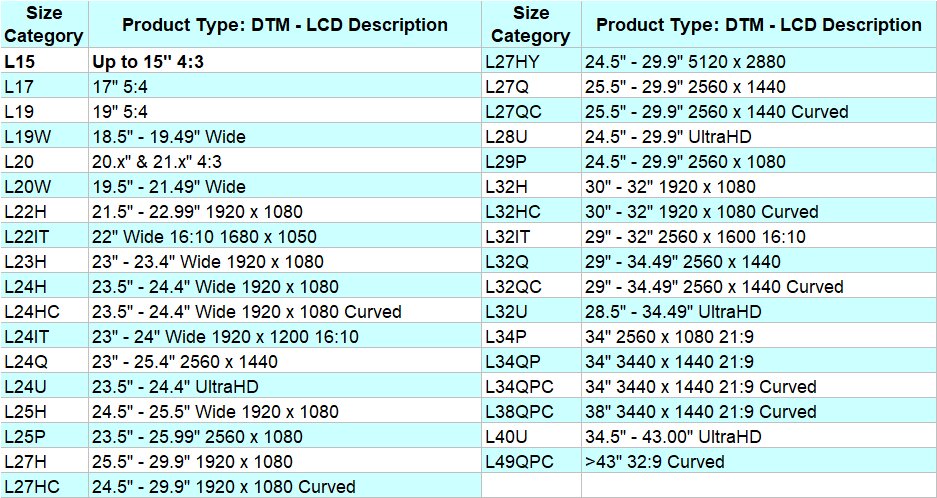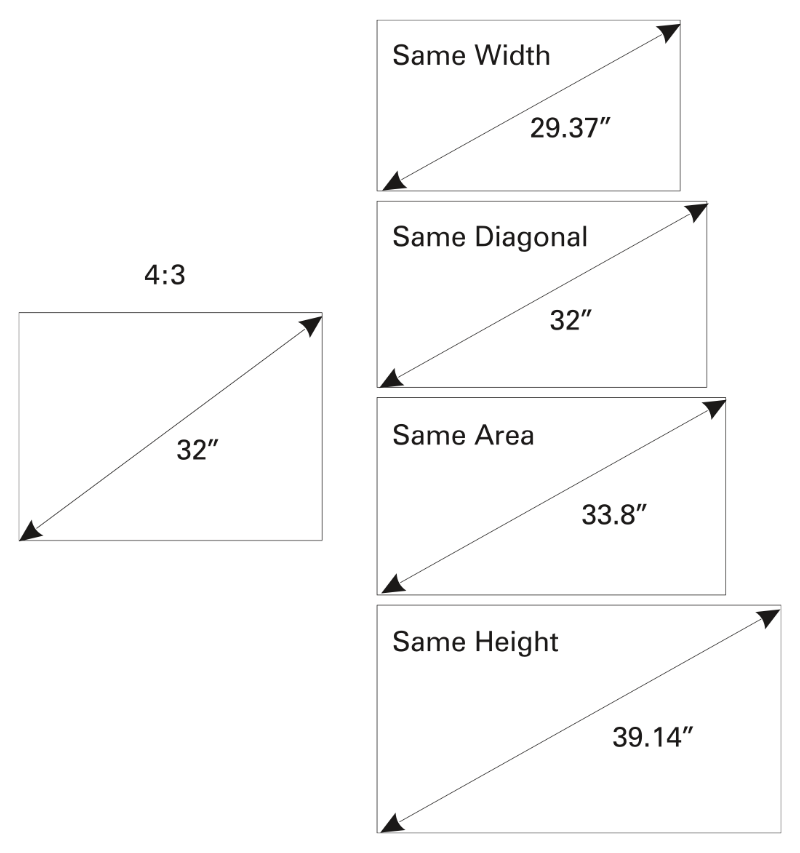Yesterday, I looked at the ergonomics of desktop monitors and why they are shaped the way they are (The Shape of (Monitor) Things to Come (Part 1)). Today, I’m going to dig a bit more into the supply side.

As we saw yesterday, once a monitor gets to a certain height on the desk, the only way to expand it for long term use without discomfort is to go wider. In the days of CRTs, the highest resolution that was reasonably mainstream was 1600 x 1200 which is a 4:3 aspect ratio. To make a wide aspect ratio desktop monitor, the resolution of 1920 x 1200 was chosen, which was a 16:10 aspect ratio. As well as being a good improvement on the 1600 x 1200, the format allowed those in content creation to work on 1920 x 1080 content with menus and status bars above and below the image.
16:10, then became the main aspect ratio for wider displays when flat panels arrived. For a while, pretty well all commercial LCDs were one of just five categories:
-
15″ 1024 x 768 (4:3)
-
17″ or 19″ 1280 x 1024 (5:4)
-
20″/21″ 1600 x 1200 (4:3) and
-
24″ 1920 x 1200 (16:10)
(As an aside, I had 20 years of tracking and forecasting the Desktop Monitor market in Europe. I remember the long argument I had with one of my colleagues when I thought we should expand the number of categories that we had for analysis of CRTs from 4 to 5 as I thought we should split 17″ into 48KHz models and 64Khz models. By the time we stopped that service in 2020, the number of categories for LCDs with reasonable volume had expanded to 35! If you tried to analyse by actual resolutions, sizes and curved/not curved, you would probably have to cover more than 100 – if you ignored WCG and specialist gaming monitors!)
 Over twenty years, the market went from 5 CRT categories to 5 LCDs to 35. And there are probably more to come!
Over twenty years, the market went from 5 CRT categories to 5 LCDs to 35. And there are probably more to come!
Flat panels can be pretty well any shape, but the most economical shapes are those where the number of panels from a big substrate is optimised and where the amount of glass that is wasted with no panel on it is minimised. G5 LCD fabs were optimised around desktop monitors at 17″ and 19″ and the lower costs that became possible really led to the big surge in the switch from CRTs to LCDs on the desktop.
The next target application for the panel makers, after notebooks and monitors, was TV. In TV, the wide format was 16:9 aspect ratio in 1280 x 720, 1366 x 768 or 1920 x 1080 format. Panel makers optimised their G6 substrate sizes (around 1.5m x 1.8m) to cut 16:9 panels. Originally, TV panels were the only panels made on those fabs, but as the markets developed, notebook panels started to be made on G5 fabs, pushing monitors onto G6 and TVs onto G7 and above.
I once met a product manager at CMO that claimed to be the person that realised that if his G6 fab made 16:9 panels for monitors, rather than 16:10, he could make more panels. One of the key points is that the nominal diagonal could stay the same or even slightly increase, but the area of glass would reduce*. As his costs were based on the area of glass, if he could sell the panels for almost the same price, he could make better profits (or at least less loss, depending where we were in the Crystal Cycle).
 This chart shows the relative area (27″ 16:9 = 100%) of different aspect ratios at the same diagonal (to scale) and the area of glass used for each one. Image:Meko
This chart shows the relative area (27″ 16:9 = 100%) of different aspect ratios at the same diagonal (to scale) and the area of glass used for each one. Image:Meko
As soon as the idea was shown as working, other panel makers jumped on the 16:9 bandwagon and pretty soon all the new sizes being developed were based on 16:9 format and 1920 x 1080 format became the mainstream. That is to say, except for the corporate market in Germany which had, by then, standardised on 24″ 16 x 10 as being ergonomically better than 16 x 9. They were prepared to pay a bit more to get what they want, so when I was doing market research on the desktop monitor market still, around three years ago, Germany represented something like 40% of the global market for 24″ 1920 x 1200 monitors. (One of the factors, I believe, is that Europeans use A4 paper, which is deeper than the US letter size and the extra vertical resolution helped with reading pdfed documents in portrait mode).
Going bigger than 24″, though, really needs more pixels than even 1920 x 1200 and the next step up was to 27″ 16:9 format at 2560 x 1440. That format was really promoted and exploited by Dell who did very well with it and I have believed for years that the size/resolution was a long term ‘sweet spot’ on the desktop. There is enough resolution for multiple windowed applications, but the monitor is not too big or too high for good ergonomics.
16:9 monitors for the desktop have moved up to 32″ and 3840 x 2160 format, but they are a bit big for some people and the display height is also quite high. I have one of these monitors, that I love, but I have the bottom jammed as low down as I can get it to reduce the height. After all, in Windows, the menus, browser tabs etc are at the top of the screen, and you don’t want those too high, as I discussed yesterday.
So if you can’t go higher, you need to go wider if you want to continue to go up in size and resolution. If you take a 24″ 1920 x 1080 resolution panel and move it to 21:9 aspect ratio, you end up with a 29″ panel that is 2520 x 1080 and they were developed. That was fine for consumer applications, but really didn’t have enough vertical resolution, so the next development was to extend the 27″ format to 34″ or 35″ giving 3440 x 1440 resolution (actually, 21.5:9 if you are picky!). That’s also a very nice size and sweet spot for wide desktop monitors. (see this DD from 2015 Wider Still and Wider….) The category has been further developed to include 38″ 3840 x 1600 format (which is actually 24:10 aspect ratio!).
At 34″ wide format, you run into an additional ergonomic challenge. The problem is that at that width, the change in focal length and viewing angles at the edges of the display can cause less comfort in long use. The solution is to curve the display. I never liked the idea of curved TVs and they didn’t catch on, but curved monitors, optimised for a single user, always made sense to me. Once you start to curve the display (no mean feat if you look at how an LCD works), you can go even wider so you get products such as the 32:9 49″ monitors that are 5120 x 1440 resolution and are, effectively, the same as two 27″ 2560 X 1440 monitors side by side, but missing the very irritating bezels in the middle if you actually had two individual monitors.
I guess, the logical extension of this idea is a 58″ 32:9 monitor with 7680 x 2160 resolution that is, effectively the equivalent of dual 32″ monitors side by side. I haven’t seen one of those, but it wouldn’t surprise me if somebody is or has developed such a beast to see what the implications are!
Up to now, I have been talking pretty well exclusively of LCDs, as OLED monitors have been ‘noise not signal’. However, OLEDs for IT are the next step for the Korean display makers as they look to keep distance between themselves and their Chinese competitors. And OLEDs are much easier to bend than LCDs because the active layers are so thin. For that reason, I would expect the longer term trend will be to wide and curved displays on the desktop for those that really care about their monitors, while 27″ 2560 x 1440 will, eventually, become the mainstream.
Although dual displays on PCs have become more popular in recent years, the flexibility of one single display surface is hard to beat and if you have an even number of monitors, the bezels are going to be right in the middle, where you don’t want them, so even though I have a friend that like the visual isolation of 4 separate 1920 x 1080 monitors, with one for each app, I would not be without the ability to have dual documents or webpages side by side on my 32″.
Anyway, getting back to the trigger for these articles, I’m not convinced about the 16:18 LG display, except in applications where there is simply not room for that resolution in another shape. Still, it’s good to see companies trying things! (BR)
Note that this article and Part 1 from yesterday (The Shape of (Monitor) Things to Come (Part 1)) count as only one towards your allowance of free articles if you do not have a paying subscription.
*Now, the cynical among you may have noticed that monitors are more or less ‘sold by the inch’. By going to wider and wider aspect ratios, for any given diagonal, the wider the aspect ratio, the less the area of display. That, in itself, is a good reason for monitor and panel makers to want to push wide aspect ratios! The diagram below how the diagonal changes keeping different parts of the display size fixed.



